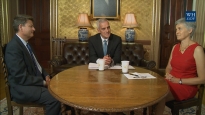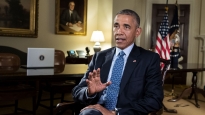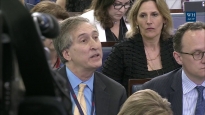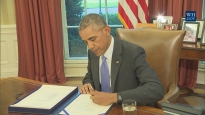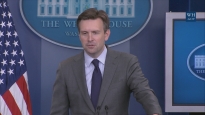President Obama Speaks on No Child Left Behind Reform
February 09, 2012 | 8:59 | Public Domain
The President announces that 10 states will receive flexibility to implement reforms that raise standards for student achievement without being required to meet certain parts of No Child Left Behind.
Remarks by the President on No Child Left Behind Flexibility
East Room
1:57 P.M. EST
THE PRESIDENT: Please have a seat, have a seat. Thank you so much. Well, hello, everybody, and welcome to the White House.
I want to start by thanking all the chief state school officers who have made the trip from all over the country. Why don’t you all stand up just so we can see you all, right here. (Applause.) It’s a great group, right here. Thank you. And I want to recognize someone who is doing a pretty good job right here in Washington, D.C., and that is my Secretary of Education Arne Duncan. Love Arne. (Applause.)
We’ve also got some outstanding members of Congress who are here who have always been on the front lines when it comes to education reform. But above all, I want to thank all the teachers who are here today. Where are the teachers? Come on, stand up, teachers. (Applause.) There you go. We got some teachers here.
Earlier this week, we hosted our second White House science fair. Some of you may have seen this on TV. I got a chance to shoot a marshmallow out of an air cannon, which I don’t usually get to do. (Laughter.) But I met these incredibly talented young people -- kids who are working on everything from portable housing for disaster victims to technology that can detect smuggled uranium before it became a threat; this young man had built a prototype. And I asked him how he came up with this idea, and he said, “I’ve always just been really interested in nuclear materials, and I collect samples.” (Laughter.) And I asked him, “How does your mom feel about this?” (Laughter.) He said she wasn’t that happy about it.
But just unbelievable young people. It was extraordinary. And before they left, I gave them some homework. I told them go find a teacher who helped them make it here and say thank you, because every single one of us can point to a teacher who in some way changed the course of our lives. I certainly can; I know Arne can. And the impact is often much bigger than we realize.
One study found that a single good teacher can increase the lifetime earnings of a classroom by $250,000 -- single teacher. A great teacher can help a young person escape poverty, allow them to dream beyond their circumstances.
So teachers matter. And in an economy where employers are looking for the most skilled, educated workers, few people are going to have a bigger impact on that than the men and women who are in our classrooms. And that ultimately is why we’re here today. It’s about our classrooms, and our children, and what’s happening to them and how they can perform.
In September, after waiting far too long for Congress to act, I announced that my administration would take steps to reform No Child Left Behind on our own. This was one of the first and the biggest “We Can’t Wait” announcements that we’ve made, because our kids and our schools can’t be held back by inaction.
I want to point out, by the way, the members of Congress who are here, they’re ready to act, but we haven’t been able to get the entire House and Senate to move on this.
I said back then the goals of No Child Left Behind were the right ones. Standards and accountability -- those are the right goals. Closing the achievement gap, that’s a good goal. That’s the right goal. We’ve got to stay focused on those goals. But we’ve got to do it in a way that doesn’t force teachers to teach to the test, or encourage schools to lower their standards to avoid being labeled as failures. That doesn’t help anybody. It certainly doesn’t help our children in the classroom.
So we determined we need a different approach. And I’ve always believed that each of us has a role to play when it comes to our children’s education. As parents, we’ve got a responsibility to make sure homework gets done, but also to instill a love of learning from the very start. As a nation, we’ve got a responsibility to give our students the resources they need -- from the highest-quality schools to the latest textbooks to science labs that actually work.
In return, we should demand better performance. We should demand reform. And that was the idea behind Race to the Top. For less than 1 percent of what our nation spends on education each year, we’ve gotten almost every state in the nation to raise their standards for teaching and learning. And that’s the first time that’s happened in a generation.
So when it comes to fixing what’s wrong with No Child Left Behind, we’ve offered every state the same deal. We’ve said, if you’re willing to set higher, more honest standards than the ones that were set by No Child Left Behind, then we’re going to give you the flexibility to meet those standards. We want high standards, and we’ll give you flexibility in return. We combine greater freedom with greater accountability. Because what might work in Minnesota may not work in Kentucky -- but every student should have the same opportunity to reach their potential.
So over the last five months, 39 states have told us that they were interested. Some have already applied. And today, I am pleased to announce that we are giving 10 states, the first 10 states the green light to continue making the reforms that are best for them.
Each of these states has set higher benchmarks for student achievement. They’ve come up with ways to evaluate and support teachers fairly, based on more than just a set of test scores. And along with promoting best practices for all of our children, they’re also going to be focusing on low-income students, and English language learners, and students with disabilities -- not just to make sure that those children don’t fall through the cracks, but to make sure they have every opportunity to go as far as their talents will take them.
So Massachusetts, for example, has set a goal to cut the number of underperforming students in half over the next six years. I like that goal.
Colorado has launched a website that will allow teachers and parents to see exactly how much progress students are making, and how different schools are measuring up. So nothing creates more accountability than when parents are out there taking a look and seeing what’s going on.
New Jersey is developing an early warning system to reduce the number of dropouts. Tennessee is creating a statewide school district to aggressively tackle its lowest-performing schools. And Florida has set a goal to have their test scores rank among the top five states in the country, and the top 10 countries in the world. I like that ambition.
This is good news for our kids; it’s good news for our country. And I’m confident that we’re going to see even more states come forward in the months ahead. Because if we’re serious about helping our children reach their full potential, the best ideas aren’t going to just come from here in Washington. They’re going to come from cities and towns from all across America. They’re going to come from teachers and principals and parents. They’re going to come from you who have a sense of what works and what doesn’t.
And our job is to harness those ideas, to lift up best practices, to hold states and schools accountable for making them work. That’s how we’re going to make sure that every child in America has the skills and the education they need to compete for the jobs of the future and to be great citizens. And that’s how we’re going to build an economy that lasts.
So to all the educators who are in the room, thank you for what you do every day. We are very proud of your efforts. We know it’s not easy. We’re proud of you. And working together, I am absolutely confident that year after year we’re going to see steady improvement.
I told the superintendents that I met backstage before I came out here, this is not a one-year project. This isn’t a two-year project. This is going to take some time. But we can get it done with the kind of determination and the kind of commitment that so many of you have shown.
So I’m proud of you. I’m proud of Arne Duncan. Let’s make this happen.
Thank you very much, everybody.
END
2:07 P.M. EST
|
July 5, 2016
|
July 4, 2016
|
July 2, 2016
|
July 1, 2016
|
|
July 1, 2016
|
July 1, 2016
|
June 30, 2016
|
June 30, 2016
|
- &lsaquo previous
- …
- 36
- 37
- 38
- 39
- 40
- 41
- 42
- 43
- 44
- …
- next &rsaquo
